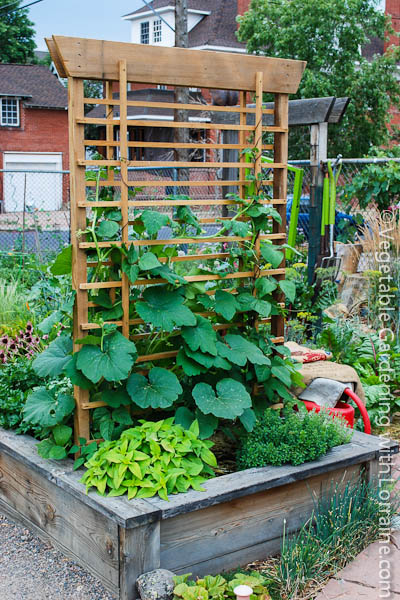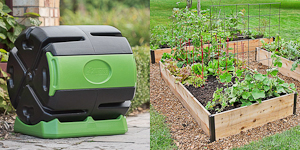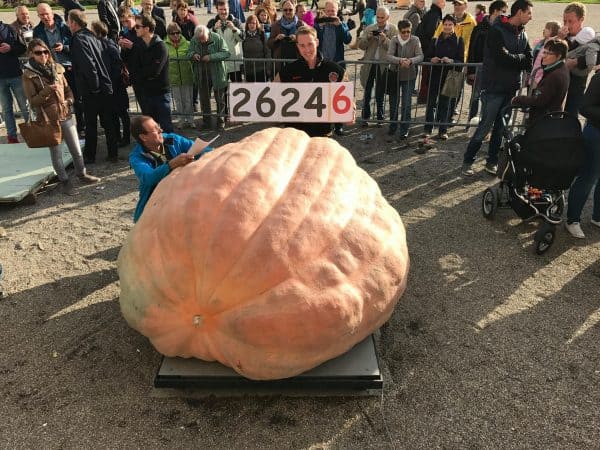- Home
- How to Grow Vegetables A-Z
- Growing Pumpkins
Growing Pumpkins
 A Growing Pumpkin Trying
A Growing Pumpkin Tryingto Hide Before Halloween
The main requirement for growing pumpkins is... space! It takes hundreds of big leaves, on sprawling vines that can grow more than twenty feet long, to grow a nice plump pumpkin.
But if you have a small garden, a raised bed, or even a container vegetable garden, you can still grow pumpkins if you choose a smaller variety (like Sugar Pie) and grow them up a sturdy pumpkin trellis instead of out across the ground.
If you're going to grow them in a container, try to get the biggest container you can find! (A free, not-so-beautiful option is an empty tree tub from a landscaping contractor, who will usually be happy to get rid of them.)
Just What IS a Pumpkin, Anyway?
Pumpkins are a winter squash. It used to be that if a winter squash variety was roundish, grooved and orange, we'd call it a pumpkin, but now there are white, warty, red, cream, gnarly, gray, striped, speckled, blue, capped and yellow winter squashes that all pass as pumpkins at every Halloween pumpkin patch stand.
So I guess if we want to call it a pumpkin... it’s a pumpkin!
Best Conditions for Growing Pumpkins
In addition to space, growing pumpkins requires heat. There’s no point in getting impatient in the spring - you just have to wait until well past frost and the soil is good and warm (70° at least, 80 is better). You can start growing pumpkin seedlings indoors if you just can’t stand waiting, but make sure to use the largest containers possible because pumpkins are deep-rooted plants and do NOT like to be transplanted. The shock of transplanting will usually set them back as much as if you’d just waited to direct seed.
Because they like it hot, some people grow pumpkins on mounds (aka “hills”), which heat up faster than level soil and also drain well. If you live where there are cool, late springs (higher latitudes or altitudes, or cool, wet, maritime climates), growing on mounds may be helpful.
But where I live in Colorado, it’s so hot and dry that it makes more
sense to be growing pumpkins in trenches than in mounds, to keep them
from drying to a crisp or baking to death.
Pumpkins are across-the-board feeders, and especially appreciate as much organic matter/compost as you can possibly provide. I make a ton of compost every year from kitchen scraps, garden waste, fall leaves and commercial coffee grounds that we haul in from Pablo’s (best coffee in Denver, if you’re ever in town!). When this is all rotted down it gets forked into the beds every spring, and the pumpkins especially love it.
You can also boost your nitrogen, phosphorus and potassium levels with a little added blood meal, bone meal and greensand. These organic fertilizers need good soil microflora in order to be available to the pumpkins, so use them with compost (which is rich in microflora), not instead of it.
A Great Pumpkin Trellis
 Pumpkin Trellis Over a Raised
Pumpkin Trellis Over a RaisedBed at the Community Garden
If you don’t have room on the ground to let growing pumpkins sprawl, you can grow smaller varieties up a sturdy pumpkin trellis. As the pumpkin vines grow, train them up the trellis by gently moving the vines toward it, and tying them up with cloth strips torn from an old t-shirt.
Once they realize they’re going to have to grow up, they will coil their tendrils around the trellis, and keep growing up on their own. (Sorta wish in retrospect that someone had tied me to a trellis when I was younger..., but then again, growing every which way has had its advantages, too.)
Pumpkin stems are stronger than they
look, but if you want to give your growing pumpkins some extra support,
you can place the pumpkin inside some old pantyhose, and tie it up to
the trellis. The pantyhose will stretch as the pumpkin grows.
Pollination: Boy and Girl Flowers
Pumpkins (and all winter squash) are “monoecious” which means that any given flower is either male or female. The plant will bear both types of flowers, and bees do the pollinating. If you’re growing pumpkins near other types of squashes, they will likely cross-pollinate, but this is only an issue if you want to save seeds for next year that will come back true to the parent.
If you do want to save seeds, wait for a female blossom to open in the morning, pollinate it with pollen from a male flower using a soft artist's or makeup brush, and then tape the flower shut to prevent bees from entering.
Sometimes the plant bears all male flowers at the start of the bloom, which will dry up and fall off. Since female pumpkin blossoms are only open for one day, I think the plant starts out producing only male flowers is to announce itself to the bees, so that they start coming around and are present when the female blossoms finally open.
Bugs and Other Strangers
The most common pumpkin pests are the same bugs that bother other winter squash: squash bugs, squash vine borers, aphids and cucumber beetles.
Squash bugs are big (5/8” long), grayish, shield-shaped beetles with an orange line around the edge. They bite into the leaves and suck the sap, and can cause leaves to wilt to death. Infestations can be severe if left unchecked. In the home garden, the best way to control them is either to cover the plants with floating row covers until they get big enough to resist, or to go on patrol and pick the bugs off by hand. A few won’t cause much damage, but if the get a foothold and start reproducing, they can devastate your crop. Neem oil can also work, but it is more of a reproductive disruptor than an outright killer of bugs.
Squash Vine Borers are fascinating creatures. A fly burrows into the base of the hollow pumpkin stem, lays its eggs, and when the eggs hatch into larva they eat out all the juicy insides of the stem, causing that leaf to wilt and die. The best control is to grow the pumpkins under floating row cover until they are big enough to withstand an attack. I’ve also heard that you can wrap the stems with aluminum foil at the base to keep the fly out, but I haven’t tried it.
Aphids are tiny flying guys, whose least endearing feature is that they can reproduce themselves without mating, and lay live young. This means their populations can explode overnight. Believe it or not, hitting them with a strong spray of water knocks them off the plant, and they seem to have a hard time reorganizing their feeding frenzy. You may have to do this every day for awhile, of use a homemade soap spray.
Cucumber Beetles come in a variety of colors. They can be yellow with black spots, gray with black stripes, or look like ladybugs - only with their spots in lines and with longer antennae. They chew holes in the leaves of pumpkins, and cause the most damage when the plants are little. As with squash bugs, control them by covering your pumpkins with Reemay until the plants are large enough to sustain a little damage without being destroyed, pick them off by hand, or spray with neem oil (avoiding the flowers, where bees are needed).
Diseases: Pumpkins are subject to all the diseases that other squash varieties are prone to: powdery mildew being the most common. For more information on diseases of squash, please check out the Common Plant Diseases page.
Best of luck with your pumpkin crop! I'd love to collect pictures of everyone's pumpkins here, so please join in the fun this fall, and share your pumpkin and/or trellis pictures with me on your own page here:
Create Your Own Page Here!
Do you have a raised bed or trellis idea to share? Bragging rights to a monster pumpkin, or a mistake you made that you can only laugh about in hindsight? Share it here by creating your own personal page on this site, which your family, friends and others can see and comment on. Jump on in and get your hands dirty. We know your thumbs are green!
Help share the skills and spread the joy
of organic, nutrient-dense vegetable gardening, and please...
~ Like us on Facebook ~
Thank you... and have fun in your garden!
Affiliate Disclaimer
This website contains affiliate links to a few quality products I can genuinely recommend. I am here to serve you, not to sell you, and I do not write reviews for income or recommend anything I would not use myself. If you make a purchase using an affiliate link here, I may earn a commission but this will not affect your price. My participation in these programs allows me to earn money that helps support this site. If you have comments, questions or concerns about the affiliate or advertising programs, please Contact Me.Contact Us Page




